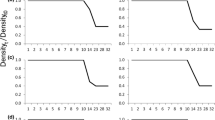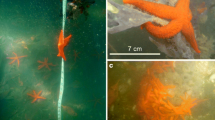Abstract
Spatial and temporal variation in recruitment of the compound ascidian Aplidium stellatum was examined on a shallow-water limestone outcropping in the Northeastern Gulf of Mexico from 1983 to 1985. Fifty-two percent of the recruits appeared on vertical surfaces, which were rare at this site. In the laboratory, tadpole larvae of A. stellatum consistently settled on vertical vs horizontal surfaces in a 2 to 1 ratio, regardless of the area of vertical surface offered. This settlement response was insufficient to account entirely for the field recruitment pattern, suggesting greater mortality of newly-settled individuals or larvae on horizontal vs vertical surfaces. Fifty-six percent of the variation in recruitment over 21 months could be explained by variation in the percentage of zooids brooding larvae in adult colonies. Over 28 consecutive months, the percentage of zooids brooding larvae was positively correlated with egg counts of the previous month (r 2=0.75), which in turn were weakly correlated with monthly average water temperature (r 2=0.36). These results suggest that larval production contributed substantially to temporal variation in recruitment of A. stellatum. The short larval life of tadpoles of A. stellatum and the relative isolation of the population were probably responsible for the correlation between recruitment and larval production.
Similar content being viewed by others
Literature cited
Bak, R. P. M., J. Sybesma and F. C. van Duyl: The ecology of the tropical compound ascidian Trididemnum solidum. II. Abundance, growth, and survival. Mar. Ecol. Prog. Ser. 6, 43–52 (1981)
Birkeland, C., L. Chang and R. A. Lewin: Motility of didemnid ascidian colonies. Bull. mar. Sci. 31, 170–173 (1981)
Buss, L. W.: Habitat selection, directional growth, and spatial refuges: why colonial animals have more hiding places. In: Biology and systematics of colonial organisms, pp 459–497. Ed. by G. Larwood and B. R. Rosen. New York and London: Academic Press 1979
Caffey, H. M.: Spatial and temporal variation in settlement and recruitment of intertidal barnacles. Ecol. Monogr. 55, 313–332 (1985)
Carlisle, D. B.: Locomotory powers of adult ascidians. Proc. R. Zool. Soc. Lond. 136, 141–146 (1961)
Cloney, R. A.: Ascidian metamorphosis: review and analysis. In: Settlement and metamorphosis of marine invertebrate larvae, pp 255–282. Ed. by F.-S. Chia and M. Rice. New York: Elsevier 1978
Connell, J. H.: The consequences of variation in initial settlement vs post-settlement mortality in rocky intertidal communities. J. exp. mar. Biol. Ecol. 93, 11–45 (1985)
Costello, D. P. and C. Henley: Methods for obtaining and handling marine eggs and embryos, 2nd ed. Woods Hole, MA: Mar. Biol. Lab. 1971
Crisp, D. J. and A. F. A. A. Ghobashy: Responses of the larvae of Diplosoma listerianum to light and gravity. In: Fourth Eur. mar. Biol. Symp., pp 443–465. Ed. by D. J. Crisp. Cambridge: Cambridge University Press 1971
Doyle, R. W.: Choosing between darkness and light: the ecological genetics of photic behavior in the planktonic larvae of Spirorbis borealis. Mar. Biol. 25, 311–318 (1974)
Ebert, T. A.: Recruitment in echinoderms. In: Echinoderm studies, pp 169–203. Ed. by M. Jangoux and J. M. Lawrence A. A. Balkema: Rotterdam 1982
Gaines, S., S. Brown and J. Roughgarden: Spatial variation in larval concentrations as a cause of spatial variation in settlement for the barnacle, Balanus glandula. Oecologia 67, 267–272 (1985)
Goodbody, I.: Continuous breeding in three species of tropical ascidian. Proc. R. Zool. Soc. Lond. 136, 403–409 (1961)
Gotelli, N. J.: Factors influencing the recruitment of two subtidal invertebrates. Doctoral dissertation, Florida State University, Tallahassee, Florida 1985
Grave, C.: Amaroucium pellucidum (Leidy) form constellatum (Verrill). I. The activities and reactions of the tadpole larva. J. exp. Zool. 30, 239–257 (1920)
Haven, N. D.: Temporal patterns of sexual and asexual reproduction in the colonial ascidian Metandrocarpa taylori Huntsman. Biol. Bull. mar. biol. Lab., Woods Hole 140, 400–415 (1971)
Keough, M. J. and B. J. Downes: Recruitment of marine invertebrates: the role of active larval choices and early mortality. Oecologia 54, 348–352 (1982)
Lambert, C. C. and C. L. Brandt: The effect of light on the spawning of Ciona intestinalis. Biol. Bull. mar. biol. Lab., Woods Hole 132, 222–228 (1967)
Loosanoff, V. L.: Variations in time and intensity of setting of the starfish Asterias forbesi, in Long Island Sound during a twenty-five year period. Biol. Bull. mar. biol. Lab., Woods Hole 126, 423–439 (1964)
MacArthur, R. H. and E. O. Wilson: The theory of island biogeography, 203 pp. Princeton: Princeton University Press 1967
Mast, S. O.: Reactions to light in the larvae of ascidians, Amaroucium constellatum and Amaroucium pellucidum with special reference to photic orientation. J. exp. Zool 34, 149–187 (1921)
Millar, R. H.: The breeding season of some littoral ascidians in Scottish waters. J. mar. biol. Ass. U.K. 37, 649–652 (1958)
Millar, R. H.: The biology of ascidians. Adv. mar. Biol. 9, 1–100 (1971)
Moinnot, C. and F. Moinnot: A key to the ascidian genera of the world. Arch. Zool. exp. gen. Notes Rev. 113, 311–367 (1972)
Olson, R. R.: Ascidian-Prochloron symbiosis: the role of larval photoadaptations in midday larval release and settlement. Biol. Bull. mar. biol. Lab., Woods Hole 165, 221–240 (1983)
Olson, R. R.: The consequences of short-distance larval dispersal in a sessile marine invertebrate. Ecology 66, 30–39 (1985)
Osman, R. W.: The influence of seasonality and stability on the species equilibrium. Ecology 59, 383–399 (1978)
Palmer, A. R. and R. R. Strathmann: Scale of dispersal in varying environments and its implications for life histories of marine invertebrates. Oecologia 48, 308–318 (1981)
Pearse, J. S. and D. J. Ernisse: Photoperiodic regulation of gametogenesis and gonadal growth in the sea star Pisaster ochraceus. Mar. Biol. 67, 121–125 (1982)
Roughgarden, J., Y. Iwasa and C. Baxter: Demographic theory for an open marine population with space-limited recruitment. Ecology 66, 54–67 (1985)
Sale, P. F.: Patterns of use of space in a guild of territorial reef fishes. Mar. Biol. 29, 89–97 (1975)
Scheltema, R. S.: Biological interactions determining larval settlement of marine invertebrates. Thalassia jugosl. 10, 263–296 (1974)
Schwartz, F. J., M. Castagna and G. Griffith: Comments on the abundance and ecology of the ascidian Amaroucium constellatum in Sinepuxent and Chincoteague Bays. Chesapeake Sci. 1, 197–199 (1960)
Sutherland, J. P.: Multiple stable points in natural communities. Am. Nat. 108, 859–873 (1974)
Thorson, G.: Reproductive and larval ecology of marine bottom invertebrates. Biol. Rev. 25, 1–45 (1950)
Underwood, A. J. and E. J. Denley: Paradigms, explanations, and generalizations in models for the structure of intertidal communities on rocky shores. In: Ecological communities: conceptual issues and the evidence, pp 151–180. Ed. by D. R. Stong Jr., D. Simberloff, L. G. Abele and A. B. Thistle. Princeton: Princeton University Press 1984
van Duyl, F. C., R. P. M. Bak and J. Sybesma: The ecology of the tropical compound ascidian Trididemnum solidum. I. Reproductive strategy and larval behavior. Mar. Ecol. Prog. Ser. 6, 35–42 (1981)
Warner, R. W. and P. L. Chesson: Coexistence mediated by recruitment fluctuations: a field guide to the storage effect. Am. Nat. 125, 769–787 (1985)
Winer, B. J.: Statistical principles in experimental design, 907 pp. Tokyo: McGraw-Hill 1971
Woodbridge, H.: Botryllus schlosseri (Pallas): the behavior of the larva with special reference to the habitat. Biol. Bull. mar. biol. Lab., Woods Hole 47, 223–230 (1924)
Yamaguchi, M.: Growth and reproductive cycles of the marine fouling ascidians Ciona intestinalis, Styela plicata, Botrylloides violaceus and Leptoclinum mitsukurii at Aburatsubo-Moroiso Inlet (Central Japan). Mar. Biol. 29, 253–259 (1975)
Yoshioka, P. M.: Role of planktonic and benthic factors in the population dynamics of the bryozoan Membranipora membranacea. Ecology 63, 457–468 (1982)
Young, C. M. and F.-S. Chia: Microhabitat-associated variability in survival and growth of subtidal solitary ascidians during the first 21 days after settlement. Mar. Biol. 81, 61–68 (1984)
Young, C. M. and F.-S. Chia: An experimental test of the shadow response function in ascidian tadpoles. J. exp. mar. Biol. Ecol. 85, 165–175 (1985)
Author information
Authors and Affiliations
Additional information
Communicated by J. M. Lawrence, Tampa
Rights and permissions
About this article
Cite this article
Gotelli, N.J. Spatial and temporal patterns of reproduction, larval settlement, and recruitment of the compound ascidian Aplidium stellatum . Mar. Biol. 94, 45–51 (1987). https://doi.org/10.1007/BF00392899
Accepted:
Issue Date:
DOI: https://doi.org/10.1007/BF00392899




